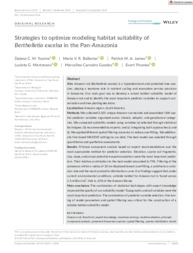Strategies to optimize modeling habitat suitability of Bertholletia excelsa in the Pan-Amazonia.
Strategies to optimize modeling habitat suitability of Bertholletia excelsa in the Pan-Amazonia.
Author(s): TOURNE, D. C. M.; BALLESTER, M. V. R.; JAMES, P. M. A.; MARTORANO, L. G.; GUEDES, M. C.; THOMAS, E.
Summary: Aim: Amazon-nut (Bertholletia excelsa) is a hyperdominant and protected tree species, playing a keystone role in nutrient cycling and ecosystem service provision in Amazonia. Our main goal was to develop a robust habitat suitability model of Amazon-nut and to identify the most important predictor variables to support conservation and tree planting decisions. Localization: Amazon region, South America. Methods: We collected 3,325 unique Amazon-nut records and assembled >100 spatial predictor variables organized across climatic, edaphic, and geophysical categories. We compared suitability models using variables (a) selected through statistical techniques; (b) recommended by experts; and (c) integrating both approaches (a and b). We applied different spatial filtering scenarios to reduce overfitting. We additionally fine-tuned MAXENT settings to our data. The best model was selected through quantitative and qualitative assessments. Results: Principal component analysis based on expert recommendations was the most appropriate method for predictor selection. Elevation, coarse soil fragments, clay, slope, and annual potential evapotranspiration were the most important predictors. Their relative contribution to the best model amounted to 75%. Filtering of the presences within a radius of 10 km displayed lowest overfitting, a satisfactory omission rate and the most symmetric distribution curve. Our findings suggest that under current environmental conditions, suitable habitat for Amazon-nut is found across 2.3 million km2, that is, 32% of the Amazon Biome. Main conclusion: The combination of statistical techniques with expert knowledge improved the quality of our suitability model. Topographic and soil variables were the most important predictors. The combination of predictor variable selection, fine-tuning of model parameters and spatial filtering was critical for the construction of a reliable habitat suitability model.
Publication year: 2019
Types of publication: Journal article
Unit: Embrapa Eastern Amazon
Keywords: Análise de componentes principais, Avaliação de modelo, Castanha, Conhecimento especializado, Entropia máxima, Expert knowledge, Filtragem espacial, Maximum entropy, Model evaluation, Modelo de distribuição de espécie, Principal component analysis, Protected Amazonian species, Spatial filtering, Species distribution model
Observation
Some of Embrapa's publications are published as ePub files. To read them, use or download one of the following free software options to your computer or mobile device. Android: Google Play Books; IOS: iBooks; Windows and Linux: Calibre.
Access other publications
Access the Agricultural Research Database (BDPA) to consult Embrapa's full library collection and records.
Visit Embrapa Bookstore to purchase books and other publications sold by Embrapa.

